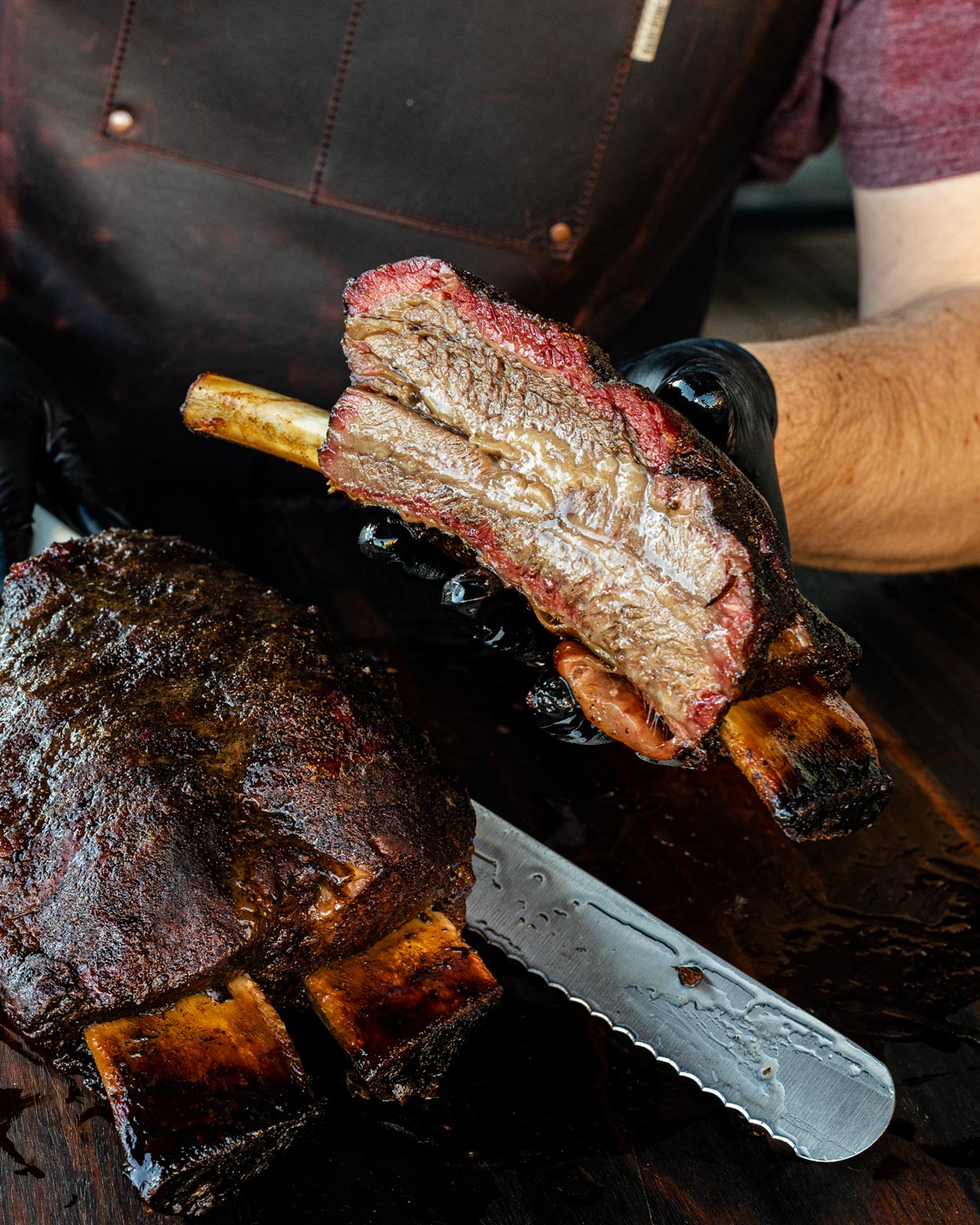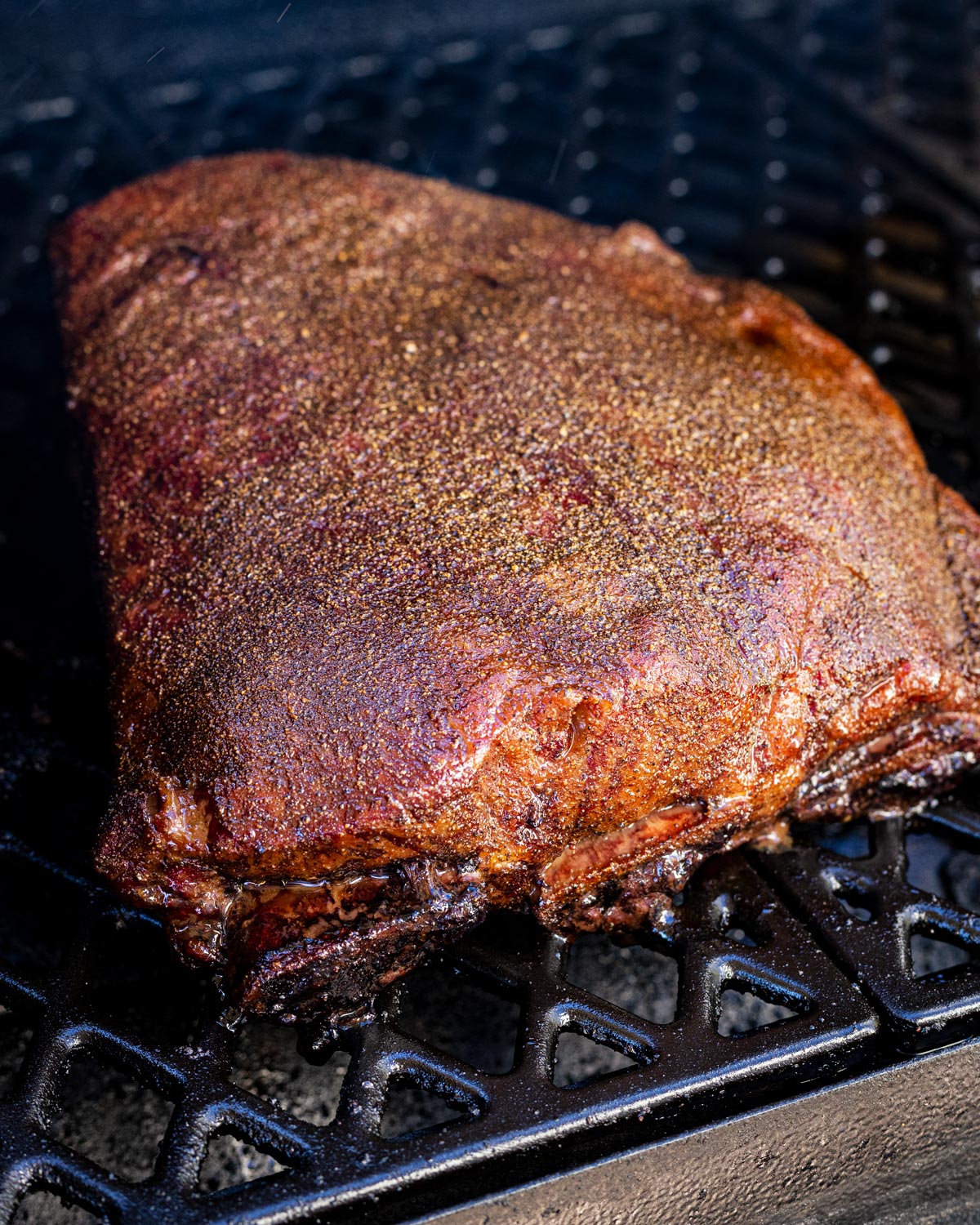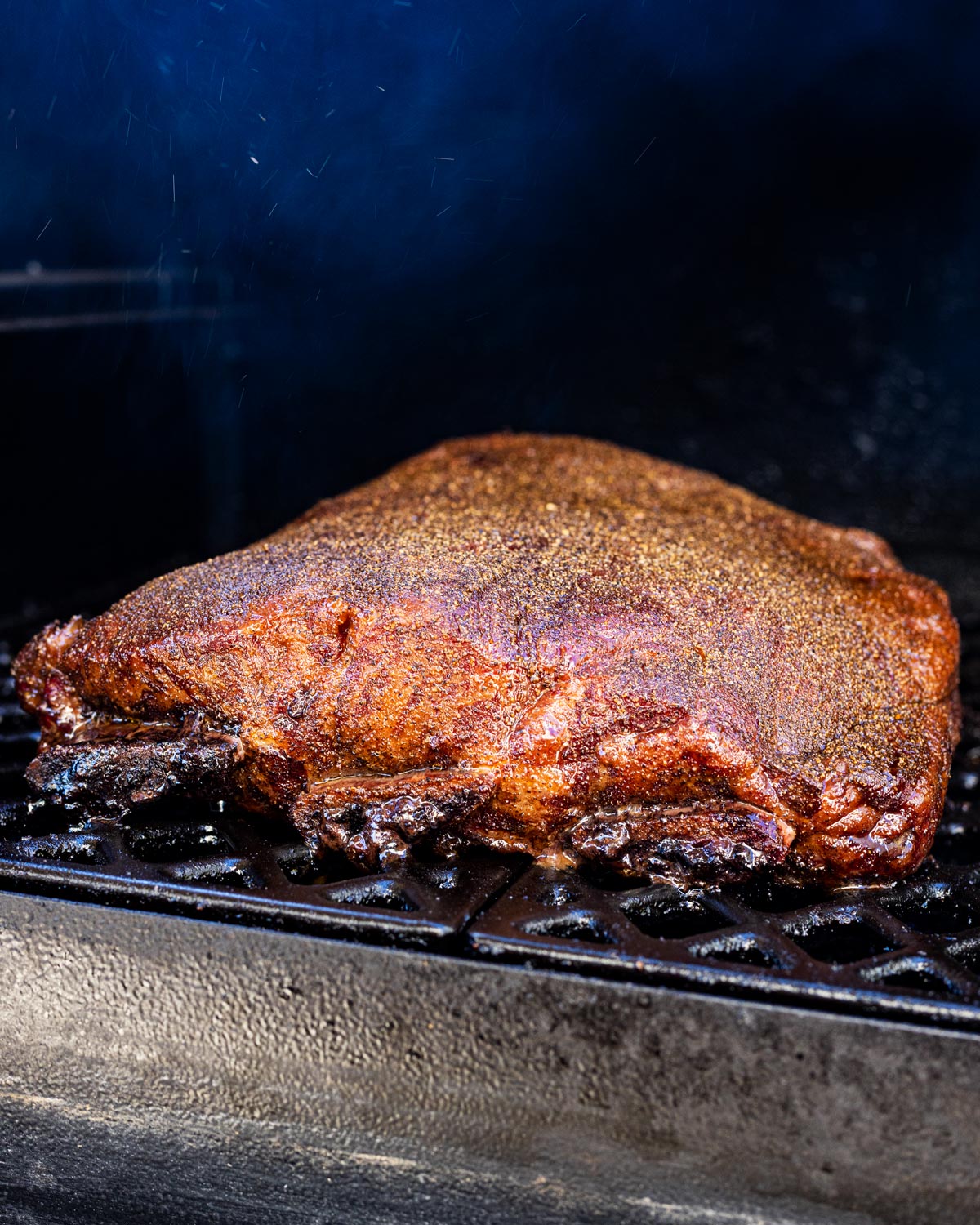Smoked Beef Ribs Recipe (Texas-Style Dino Ribs)
Smoked beef ribs are the ultimate showstopper in barbecue—massive, meaty, and packed with rich, smoky flavor. These slow-smoked ribs deliver a tender, juicy bite that will have you rolling your eyes back. In this guide, I’ll walk you through my foolproof process, from seasoning to smoking, along with variations to help you master this epic cook.
There’s something undeniably primal about holding a Flintstone-sized bone and sinking your teeth into tender, juicy smoked beef ribs.
Often referred to as ‘brisket on a stick’ or ‘dino ribs,’ these colossal beef plate ribs are the peak of meaty indulgence. Smoky, crusty, and impossibly rich, slicing into a rack of beef ribs has to be one of my favorite moments in barbecue.
The flavor and texture are very similar to Smoked Beef Brisket, but the rich fats and crispy bark remind me more of a very large Brisket Burnt End, minus the BBQ sauce. Now I’m hungry!

Why This Process Works
- Incredibly juicy and rich. Protected by the bone, the smoked beef ribs stay moist during the cook ensuring that there are no dry bites. The fat content in beef short ribs ensures every bite is rich and full of beefy flavor.
- Easy-peasy to smoke. The meat might taste similar to a smoked brisket point, but these are way easier to cook. There is also less time on the smoker, and less time required to rest.
- Sponge for flavor. Season heavily with your choice of spices, and don’t forget to spritz liquids. Beef ribs soak it all in, giving you a lot of flexibility if you want more than the classic salt and pepper.
What are Beef Plate Ribs?
It’s important to know what they are, so you can buy the correct ones. These big BBQ beef ribs can easily be mistaken for the smaller, less meaty version commonly found in grocery stores.
Beef short ribs, also known as beef plate ribs, are a section of ribs from the lower part of the rib cage close to the belly. Typically they come in a “plate” of 3 very large bones with the meat attached on the top.
Grocery stores don’t generally have these sitting out, however, you can always ask at the in-store butcher counter if they have “untrimmed short ribs” and there’s a chance they will have a full plate for you. The best place to go is your local butcher shop.
Selecting the Right Ribs
When buying ribs, be careful not to mistake beef back ribs for beef plate ribs—they might look similar at first glance, but they’re completely different. Beef back ribs have much less meat on the bone and are not a substitute for beef plate ribs. Beef back ribs have far less meat on the bone and won’t deliver the same rich, beefy experience.
While they’re still delicious (you should definitely try that recipe!), they won’t be a satisfying substitute if you’re expecting thick, meaty smoked beef ribs.
How to Smoke Beef Ribs

Step 1: Prep and Seasoning
Trim the thin layer of fat, silverskin, or connective tissue on the top of the beef ribs. Remove just enough carefully, to expose as much of the meat as possible.
There is a thick membrane underneath the bones. Do not bother trimming the membrane, which is mostly there to keep the bones in place. Very little meat exists down there, so you won’t be missing out.
You may slice them into individual ribs for this process. Smoking them will still take a long time, but you’ll have more bark with every bite.
Should I Use A Binder?
Using a binder is not necessary for beef ribs, as they have quite a bit of fat marbling. If you season the meat and allow it to rest at room temperature for about 30 minutes while the smoker warms up, the surface will become moist and the rub will embed itself into the surface.
You can use a binder, however, which is an opportunity for more flavor. Mustard doesn’t impart much flavor at all, but a thin coat of hot sauce or Worcestershire works well and comes through in the end.
Seasoning Options
Purists will stick with a Kosher salt & black pepper blend with BBQ beef ribs, but we have our favorites as well:
- Canyon Crust Beef Seasoning for a crusty, thick bark. This is a salt, black pepper, and garlic powder blend with some smoky chiles.
- Sedona Sand Fiesta Seasoning gives it a Southwest flavor
- Korean BBQ Seasoning for a spicy kick
- Signature Sweet & Smoky Rub is a classic BBQ blend
Season the beef ribs with a heavy coating of the rub. Allow the ribs to sit for at least 30 minutes before adding the meat to the smoker. This gives the beef time to sweat, allowing the rub to properly set into the surface and helps the bark form during the smoking process.
You can also season ahead of time, even up to overnight. This process is called dry-brining and can be done as long as you leave the beef uncovered on a wire rack on a baking sheet. Doing so will result in a crusty bark, which means more texture at the end.

Step 2: Smoking the Beef Ribs
Set your smoker to 275°F and place the beef ribs bone side down in the smoker when ready.
A higher heat creates a juicier finished smoked beef rib, rendering out the fat and creating a nice crispier crust. The low and slow of 225°F is not commonly used with this cut, as the large bones and membrane on the bottom already protect the meat from drying out.

Allow the beef ribs to smoke for at least an hour at this low temperature before spritzing with a spray bottle of apple cider vinegar or apple juice. This time gives the seasoning a chance to bake in, creating the foundation of the bark.
Spritz every hour, especially on the sides to keep them moist. Some folks will use just water, but this is an opportunity for flavor.
You can use beef broth, the standard apple cider vinegar for some tang, or black coffee for a darker finish as well.

Step 3: Wrap for the Finish
You do not need to wrap the smoked beef ribs, this is an optional step that will speed up the cook and gently tenderize the meat. I’ve found this is a helpful step to make sure they are extra tender.
Once the beef ribs hit 165-170°F in the thickest part of the meat and they’ve formed a nice bark, wrap them tightly with pink butcher paper. Spritz them one last time before wrapping them up.
Place them back on the smoker, bone side down, and keep cooking until they reach about 200-205°F. The meat should be probe tender. You can optionally use a higher temperature of 275-300°F to speed up the process as well.
The best way to tell if the beef ribs are done is by feel. Temperature targets are just a guide, but a probing the meat will give you a lot more information. Use your temperature probe and stick it in the thickest parts of the smoked beef ribs. You should have very little resistance, and it should feel like you are sticking the probe into a jar of peanut butter. That will tell you the fat is rendered well, and the meat is nice and soft.

Step 4: Rest and Slice
Resting the smoked beef ribs is just as important as the cooking process. When they are ready, remove the beef ribs and allow them to rest, wrapped in butcher paper, for at least 30-45 minutes at room temperature.
The initial resting will prevent them from overcooking with the carry-over cooking temperatures. If you need to rest them for longer, you can put them in an oven at the lowest temperature, or use an insulated cooler. Make sure they do not fall below 140°F for an extended period.

Sides to Serve with Beef Plate Ribs
These ribs take a long time to cook, giving you the perfect window to prep some killer sides. Here are our top picks to pair with smoked beef ribs:
- Smoked Baked Potatoes
- Southwest Creamed Corn
- Smoked Mac and Cheese
- Southwestern Coleslaw
- Southern Macaroni Salad
Frequently Asked Questions
You should expect 7-8 hours, potentially a little more. The cook time will depend on the meat and also if you choose to wrap it with butcher paper. Wrapping cuts the time down quite a bit.
Yes, but monitor their hydration. I do recommend individually wrapping each one with butcher paper when they do hit the 165°F temperature range to ensure they come out tender.
Beef short ribs have a high-fat content, and don’t really need additional liquid to help them tenderize when wrapping. Some people choose to add melted beef tallow, but they are quite rich already and I’ve found it doesn’t add a benefit.
More Smoked Beef Recipes to Love

Thank You For Trying Our Recipe!
We’re here to bring people together with bold flavors, using spice and flames to ignite the food and friendships.
If you try this recipe, please consider leaving an honest review below. You can also find more content by following Chiles and Smoke on Instagram, YouTube, and Facebook.

Smoked Beef Ribs
Grab ahold of the biggest and baddest bite in BBQ, the Smoked Beef Ribs. These massive dino ribs are rich, beefy, and incredibly juicy.
- Total Time: 6-8 hours
- Yield: About 4-5
Ingredients
- 1 section of beef plate ribs (about 4–5 pounds)
- 6–8 tablespoons of Smoky Southwest Rub, or preferred seasoning
- 1 cup beef broth, apple cider vinegar, or black coffee for spritzing
- Butcher paper for wrapping
Instructions
- Trim the thin layer of silverskin or fat from the top of the beef ribs, to expose the meat. Season all sides of the meat generously, and allow the beef to rest at room temperature for at least 30 minutes before cooking.
- Preheat the smoker to 275°F.
- Place the beef ribs in the smoker, bone-side down. Allow them to smoke for at least an hour, or until the bark has started to form. Spritz the ribs with the liquid every hour to keep them moist.
- (Wrapping) Continue to smoke until the ribs reach around 165-175° and their rising temperature starts to slow down. Remove the beef ribs and spritz them one final time before wrapping in butcher paper. Place them back on the smoker and increase the temperature to 300°F.
- (Not Wrapping) Continue to smoke the beef ribs and spritz, do not increase the smoker’s temperature.
- Once their internal temperature reaches about 200°F, start monitoring how they feel by checking them with a temperature probe. There should be very little resistance as if you’re sticking it into a jar of peanut butter.
- Remove them when ready and wrap them with butcher paper if they are not already. Allow them to rest for at least 30 minutes at room temperature, while wrapped, before slicing.
Notes
- If you need to rest them for longer, you can put them in an oven at the lowest temperature, or use an insulated cooler.
- Prep Time: 10 minutes
- Cook Time: 6-8 hours
- Category: Beef & Lamb
- Method: Smoking
- Cuisine: BBQ












So do I smoke them at 265 or 275 as you’ve written both?
Good catch! Adjusted the article, which should be around 275. It doesn’t need to be exact! Thank you